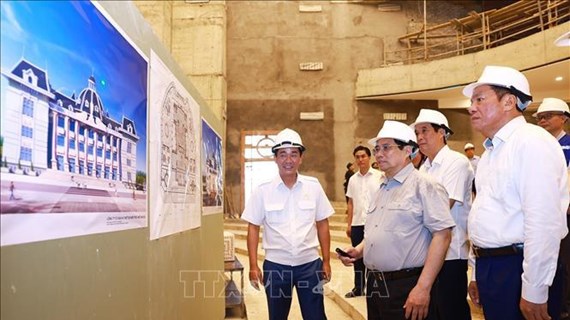Office space booms across the capital
The Hanoi office market is thriving with new commercial infrastructure,
leading to higher occupancy and decreasing rents, noted CB Richard Ellis
Vietnam Co Ltd (CBRE)'s Hanoi branch.
The Hanoi office market is thriving with new commercial infrastructure,
leading to higher occupancy and decreasing rents, noted CB Richard Ellis
Vietnam Co Ltd (CBRE)'s Hanoi branch.
The new emerging central business district (CBD) in the West continues to show considerable development, but on the other hand, the current CBD area around the Hoan Kiem district is also considered a favourable office location.
In the last five years, the number of Grade A and B office buildings have increased significantly from 35 units to 76 units, an increase of 117 percent. As a result, the availability of Grade A and B office buildings nearly tripled from 330,000 square metres to approximately 1 million square metres by the end of the final quarter of 2013.
This is a boom period for tenants, as high supply and low prices have created favourable conditions, and the tenants have a wide-array of available options that can match their expectations, according to Nguyen Bich Trang, a senior manager from the Hanoi branch's Office Service.
Due to the aforementioned increased availability of office space, rentals in West, Mid Town, and CBD have remained under check due to competitive pressure over the past few years.
For instance, in the last quarter of 2009, the highest average asking rent for a Grade A office space was recorded at a level of 50 USD per square metre per month, which at that time was amongst the highest rents in the Southeast Asian region.
Currently, the average asking rent for a Grade A office space broadly ranges between 18-43 USD per square metre per month, with the later being approximately 50 percent lower as compared to the rental levels in 2009, noted CBRE, one of the foreign property service providers in Vietnam.
One has to take into account that the current asking rents are excluding incentives, such as rent-free periods, free parking, or longer fit-out periods. Depending on the tenant, the size, and lease term, total incentives can reach up to 20 percent.
The Grade B office rentals showed a downward trend from 25 - 35 USD to 15 – 24 USD per square metre per month in 2013, which represents a staggering decrease of approximately 30-50 percent.
Despite this decline, CBRE expects that the Grade B office rentals have yet to see their lowest levels and that the Hanoi office rental levels will continue to drop in 2014.
For the Grade B market, CBRE also expects that this year, a further increase is inevitable. Regarding the Grade A market, the forecast looks less dramatic as the Lotte Center Hanoi is the only upcoming Grade A development in the capital city.
Another inevitable effect of the additional office stock is increased availability. Vacancy itself is not a bad thing as up to 5-10 percent is considered an acceptable rate in any given market, according to CBRE.
However, last year, the available space increased to 20-50 percent. The only downward trend was apparent in Grade A buildings in the West, where the Keangnam Hanoi Landmark Tower and Indo Plaza Hanoi have been steadily leasing out their office space since their completion in 2011.
The increasing office stock has helped to strengthen the net absorption in Hanoi . The five-year net average absorption (2009 – 2013) was 84,000 square metres per annum. The average net absorption over the past two years was even higher, at 91,000 square metres.
" Hanoi has been recording historically high take-up numbers, which is the result of decreasing rental levels along with an ongoing flow of new office developments," claimed CBRE.
"It, therefore, becomes attractive for especially large tenants to relocate and expand their Hanoi office," Trang reported.-VNA
The new emerging central business district (CBD) in the West continues to show considerable development, but on the other hand, the current CBD area around the Hoan Kiem district is also considered a favourable office location.
In the last five years, the number of Grade A and B office buildings have increased significantly from 35 units to 76 units, an increase of 117 percent. As a result, the availability of Grade A and B office buildings nearly tripled from 330,000 square metres to approximately 1 million square metres by the end of the final quarter of 2013.
This is a boom period for tenants, as high supply and low prices have created favourable conditions, and the tenants have a wide-array of available options that can match their expectations, according to Nguyen Bich Trang, a senior manager from the Hanoi branch's Office Service.
Due to the aforementioned increased availability of office space, rentals in West, Mid Town, and CBD have remained under check due to competitive pressure over the past few years.
For instance, in the last quarter of 2009, the highest average asking rent for a Grade A office space was recorded at a level of 50 USD per square metre per month, which at that time was amongst the highest rents in the Southeast Asian region.
Currently, the average asking rent for a Grade A office space broadly ranges between 18-43 USD per square metre per month, with the later being approximately 50 percent lower as compared to the rental levels in 2009, noted CBRE, one of the foreign property service providers in Vietnam.
One has to take into account that the current asking rents are excluding incentives, such as rent-free periods, free parking, or longer fit-out periods. Depending on the tenant, the size, and lease term, total incentives can reach up to 20 percent.
The Grade B office rentals showed a downward trend from 25 - 35 USD to 15 – 24 USD per square metre per month in 2013, which represents a staggering decrease of approximately 30-50 percent.
Despite this decline, CBRE expects that the Grade B office rentals have yet to see their lowest levels and that the Hanoi office rental levels will continue to drop in 2014.
For the Grade B market, CBRE also expects that this year, a further increase is inevitable. Regarding the Grade A market, the forecast looks less dramatic as the Lotte Center Hanoi is the only upcoming Grade A development in the capital city.
Another inevitable effect of the additional office stock is increased availability. Vacancy itself is not a bad thing as up to 5-10 percent is considered an acceptable rate in any given market, according to CBRE.
However, last year, the available space increased to 20-50 percent. The only downward trend was apparent in Grade A buildings in the West, where the Keangnam Hanoi Landmark Tower and Indo Plaza Hanoi have been steadily leasing out their office space since their completion in 2011.
The increasing office stock has helped to strengthen the net absorption in Hanoi . The five-year net average absorption (2009 – 2013) was 84,000 square metres per annum. The average net absorption over the past two years was even higher, at 91,000 square metres.
" Hanoi has been recording historically high take-up numbers, which is the result of decreasing rental levels along with an ongoing flow of new office developments," claimed CBRE.
"It, therefore, becomes attractive for especially large tenants to relocate and expand their Hanoi office," Trang reported.-VNA













